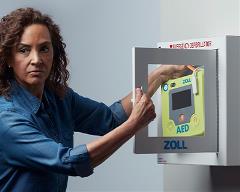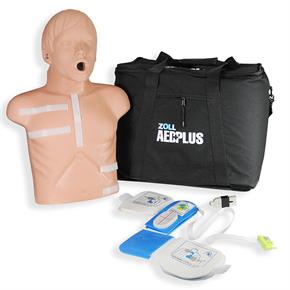AED Program Checklist: Seven Steps to Ensuring Awareness

Overview
According to the Occupational Safety and Health Administration (OSHA), sudden cardiac arrest (SCA) accounts for 13 percent of all workplace fatalities and is the leading cause of death in the United States. Are you prepared to respond to an SCA emergency?
The Importance of AEDs
Investing in Automated External Defibrillator (AEDs) and making early defibrillation a part of your emergency-response plan is important. Here’s why:
- Defibrillation within three minutes of SCA increases the chances of survival to 70 percent. A shock within one minute of collapse raises the survival rate to 90 percent.
- Calling 911 is necessary but the wait for first responders may take too long. The average call-to-shock time in a typical community is nine minutes.
- OSHA now recommends AEDs in the workplace, and legislation in your state may require workplaces to provide them.
Spreading Awareness of AEDs in the Workplace
According to the American Heart Association, only 51% of employees can locate an AED in their workplace. Because early defibrillation can mean the difference between life and death, it’s important to help build a culture of awareness. Here’s how you can start doing that today:

- Make sure everyone in your workplace knows where your AEDs are located. Place signage that clearly guides employees on where to find AEDs.
- Distribute flyers, emails, or posters with basic facts about SCA to everyone in your organization.
- Create a workplace safety task force that offers regular AED training and certification and encourage all employees to participate.
- Send email blasts to inform all employees about the AED program. Use posters and signage to promote it.
- Encourage employees to ask questions about SCA and using an AED in the workplace.
- Set up a company-wide training program that covers AEDs, workplace safety, and how to respond during an emergency.
When your colleagues know where AEDs are located, know how to use them, and understand the role they play in saving lives, they are empowered to help save lives.
All AED placement and awareness programs require regular review and maintenance – and a purpose-built checklist such as the following will help to ensure your program is in top shape:
- PROPER PLACEMENT - AEDs should be placed in visible areas, and anyone should be able to find and retrieve one within three minutes from any location in the building. Recommended locations for AEDs include cafeterias, main reception areas, fitness centers, main corridors, and outside elevators and stairwells.
- ENCOURAGE TRAINING - People who are trained in CPR and the use of an AED are typically more confident in the event of an SCA. Recommend training programs in which your employees can easily enroll, such as:
- SERVICE, SUPPORT, AND MAINTENANCE - Most AEDs are reliable throughout their lifespan, but it’s important to have a qualified support team available in case of problems. PlusCare™ is an on-site service and maintenance arm of Rescue Ready® Services that sends certified technicians to your business to troubleshoot device issues and replace expired pads/batteries, etc. for your ZOLL devices.
- IMPLEMENT AN AED MANAGEMENT PROGRAM - If you will be managing a fleet of AEDs, consider joining a program management service such as PlusTrac™, an interactive, web-based platform that will send you email alerts about ZOLL AED maintenance, including pad, battery, and AED device expiration dates. It will also keep you up to date on software updates, track your team members’ CPR/AED certification status, and more.

- AED TRAINING AND CERTIFICATION - Regular ongoing training is an important part of any AED program. ZOLL’s PlusLearning™ includes a national network of experienced, certified trainers who can provide AED, CPR, and first aid training in small, personalized classes, giving your volunteer responders the competence and confidence needed to help save a life.
- RAISE AWARENESS - Once you’ve installed AEDs in the appropriate areas of your workplace, make sure every employee knows where to find them and how to use them. Ask your organization’s human resources team to help with corporate communications such as email blasts, posters, signage, and other initiatives that raise awareness about the importance of early defibrillation in the workplace. Every step you take reinforces your company’s commitment to employee safety.
- DEVELOP AN ONGOING MAINTENANCE PLAN - All AEDs require regular upkeep and maintenance. While ZOLL AEDs are relatively low-maintenance, safety and risk managers need to periodically ensure that the devices are passing self-tests and that pads and batteries have not expired. However, maintaining a compliant AED Program goes beyond just making sure an AED is ready to use; it also involves ensuring that you have trained responders with current certifications, you comply with local and state laws, and your AEDs are regulatory maintained/inspected.


